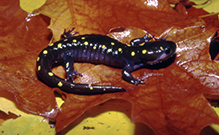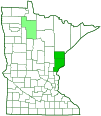Spotted Salamander
(Ambystoma maculatum)
Conservation • Description • Habitat • Biology • Distribution • Taxonomy
Conservation Status |
|
|||||||
| IUCN Red List | LC - Least Concern |
|||||||
| NatureServe | N5 - Secure S3 - Vulnerable |
|||||||
| Minnesota | Special Concern Species in Greatest Conservation Need |
|||||||
Description |
||
Spotted salamander is a medium to large sized mole salamander. It occurs in the United States from Maine to northern Georgia, west to eastern Minnesota and eastern Texas, and in southern Canada from Nova Scotia west to Ontario. It was first discovered in Minnesota in Pine County in 2001, then in Carlton County in 2005. It is found in mature deciduous, coniferous, and mixed forests with shallow seasonal ponds or small shallow wetlands that do not contain fish. Adults are 6″ to 10″ (15 to 25 cm) in length. Females tend to be larger than males. The head is wide and is often swollen at the back of the jaw. The snout is broadly rounded. The lower lip is gray. The body is stout. On each side between the forelimbs and the ventral area there are 11 to 13 prominent vertical depressions (costal grooves). The skin is soft and moist. There are four well-developed limbs that project sidewards. The hind legs have five toes. The fore legs have four toes. The upper side of the body is black or dark gray with two irregular rows of round yellow spots extending from the top of the head to the tip of the tail. Occasionally some or all of the spots on the head are orange. Unspotted individuals, albinos, and partial albinos are rare. The underside is gray and unspotted. |
||
Size |
||
6″ to 10″ (15 to 25 cm) |
||
Similar Species |
||
Habitat |
||
Mature deciduous, coniferous, and mixed forests with shallow season ponds or small shallow wetlands that do not contain fish. |
||
Biology |
||
Behavior |
||
The adult spends most of its time under a log or rock or in an abandoned animal burrow, usually within 100 meters of the pond in which it hatched. It normally emerges only on rainy nights, and then only if there is not enough food underground. During breeding season, it emerges and returns to its pond. When threatened it will respond by lowering its head, arching its back and tail, head butting, snapping, and waving its tail. Large glands on the back and tail exude a milky, toxic liquid in response to a predator. |
||
Lifespan |
||
Usually 20 to 25 years, sometimes up to 30 years, in the wild |
||
Life Cycle |
||
|
||
Larva Food |
||
Insects, mosquito and other insect larvae, water fleas, copepods, and other small aquatic invertebrates. |
||
Adult Food |
||
Earthworms, beetles, spiders, centipedes, snails, slugs, and other invertebrates. |
||
Distribution |
||||
|
Sources 4, 6, 14, 24, 29, 30, 60, 73, 76, 78. VertNet has two historical records with a single location in Beltrami County and a single date in 1950 (light green on the map). There are no Minnesota records from any other source outside of Pine and Carlton Counties. |
|||
| 2/1/2023 | ||||
Occurrence |
||||
Rare in Minnesota |
||||
Taxonomy |
|||
| Class | Amphibia (Amphibians) | ||
| Superorder | Batrachia (frogs and salamanders) | ||
| Order | Caudata (Salamanders) | ||
| Suborder | Salamandroidea (Mole Salamanders) | ||
Family |
Ambystomatidae (Mole Salamanders) | ||
Genus |
Ambystoma (Mole Salamanders) | ||
Disagreement persists about the use of the names Caudata and Urodela for the order of salamanders. Some authors use Caudata for the crown group and Urodela for the total group. Currently (2023), most authors use Urodela for the crown group and Caudata for the total group. |
|||
Subordinate Taxa |
|||
|
|||
Synonyms |
|||
Ambystome argus Ambystoma carolina Ambystoma carolinae Ambystoma subviolaceum Camarataxis maculata Lacerta maculata Lacerta subviolacea Salamandra argus Salamandra maculata Salamandra margaritifera Salamandra subviolacea Salamandra venenosa Salamandroidis subviolacea Siredon maculatus |
|||
Common Names |
|||
Spotted Salamander yellow-Spotted Salamander |
|||
Visitor Photos |
|||||
Share your photo of this amphibian. |
|||||
| This button not working for you? Simply email us at info@MinnesotaSeasons.com. Attach one or more photos and, if you like, a caption. |
|||||
Jeff LeClere |
|||||
 |
|||||
MinnesotaSeasons.com Photos |
|||||
|
|||||

Slideshows |
||
Spotted Salamander (Ambystoma maculatum) |
||
 |
||
Dave Huth - Ambystoma maculatum |
||
 |
||
About
dave.huth@yahoo.com |
||

Visitor Videos |
|||
Share your video of this amphibian. |
|||
| This button not working for you? Simply email us at info@MinnesotaSeasons.com. Attach a video, a YouTube link, or a cloud storage link. |
|||
Other Videos |
|||
| Spotted salamander (Ambystoma maculatum) Clauss Video Archive |
|||
About
May 11, 2018 Hope you enjoy a close up look at these Spotted Salamanders (Ambystoma maculatum). Mole salamanders like these with their characteristic yellow spots spend most of their lives below ground and are seldom seen. I filmed this on the first rainy spring night with temperatures hovering around 50 degrees. Conditions were perfect for the early spring migration of the amphibians in the state of New Hampshire (known as the Big Night) as they made their way to vernal pools and wetlands for the start of the mating season. The end of the video shows salamander jelly masses (egg clusters) that I filmed the following morning in a vernal pool located about ten feet from where I found the salamanders. |
|||
| SaminalPlanet Species Profile: Spotted Salamander (Ambystoma maculatum) Saminal Planet |
|||
About
Apr 8, 2018 Join me and learn a few facts about the incredible Spotted Salamander! Don't forget to like, share, and subscribe! |
|||

Created: 2/1/2023
Last Updated:


